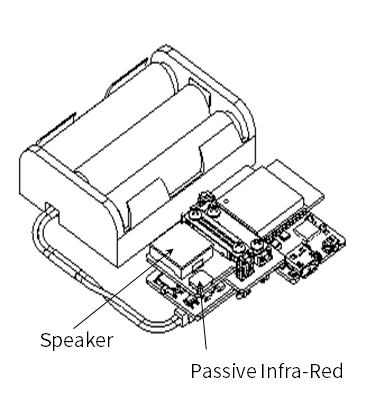人感センサ
概要
SP&PIRリーフに搭載された近距離検出用途の赤外線センサIC(AKM AK9754AE)を使って、人が近づいたら音が鳴るシステムを作りましょう。

使用するリーフ
以下のリーフを使用します
| Type | Name | Q’ty |
|---|---|---|
| AZ62 | Connector Cover | 2 |
| AI02 | SP&PIR | 1 |
| AX07 | Back to back | 1 |
| AP02 | ESP32 MCU | 1 |
| AV04 | 2V~4.5V | 1 |
| AZ63 | Nut Plate | 2 |
| AAA battery holder | 1 | |
| AAA battery | 3 | |
| M2*8mm screw | 2 | |
| M2*12mm screw | 2 | |
| φ10x2mm magnet | 1 |
リーフの組み立て
下図のようにリーフを組み立てましょう。

ソースコード
Arduino IDEで下記のプログラムを書きましょう。
- ビープ音の場合
//=====================================================================
// Leafony Platform sample sketch
// Application : Human_Sensing (Beep)
// Processor : ESP32-WROOM-32 (ESP32 Dev Module)
// Arduino IDE : 1.8.13
// Arduino ESP32: 1.0.4
//
// Leaf configuration
// (1) AI02 SP&PIR
// (2) AP02 ESP32 MCU
//
// (c) 2021 LEAFONY SYSTEMS Co., Ltd
// Released under the MIT license
// https://opensource.org/licenses/MIT
//
// Rev.00 2021/04/01 First release
//=====================================================================
//---------------------------------------------------------------------
// difinition
//---------------------------------------------------------------------
#include <Wire.h> // I2C
//-----------------------------------------------
// IO pin name definition
// Define it according to the leaf to be connected.
//-----------------------------------------------
#define PIR_INT 4 // D2 IO4
#define BUZZER_OUT 13 // D5 IO13 buzzer output
//------------------------------
// Tone setting
//------------------------------
#define LEDC_CHANNEL_0 0 // use first channel of 16 channels (started from zero)
#define LEDC_TIMER_13_BIT 13 // use 13 bit precission for LEDC timer
#define LEDC_BASE_FREQ 5000 // use 5000 Hz as a LEDC base frequency
//-----------------------------------------------
// Define constants to be used in the program
//-----------------------------------------------
#define I2C_PIR_ADDR 0x65
#define I2C_SEND_BUF_LENGTH 10
#define I2C_RECV_BUF_LENGTH 10
unsigned char i2c_sendBuf[I2C_SEND_BUF_LENGTH];
unsigned char i2c_recvBuf[I2C_RECV_BUF_LENGTH];
double irData;
double tempData;
volatile int HumanDetected = 0;
//=====================================================================
// setup
//=====================================================================
void setup(){
// initialize serial communication at 115200 second per second:
Serial.begin(115200);
// initialize i2c communication:
Wire.begin();
delay(100);
//人感センサ設定
i2c_write_byte(I2C_PIR_ADDR, 0x20, 0xFF); //CNTL1 Resrt
i2c_write_byte(I2C_PIR_ADDR, 0x2A, 0xF2); //CNTL11 人感アルゴリズム有効/割り込み出力有効
i2c_write_byte(I2C_PIR_ADDR, 0x25, 0x0F); //CNTL6 センサゲイン205%(最大)
i2c_write_byte(I2C_PIR_ADDR, 0x2B, 0xFF); //CNTL12 Mode=1 start Meas(連続測定モード)
delay(1000);
// Beep
ledcSetup(LEDC_CHANNEL_0, LEDC_BASE_FREQ, LEDC_TIMER_13_BIT);
ledcAttachPin(BUZZER_OUT, LEDC_CHANNEL_0);
// 人接近検知割り込み
attachInterrupt(PIR_INT,onHumanDetected , FALLING );
}
//---------------------------------------------------------------------
// Interrupt setting
//---------------------------------------------------------------------
//----------------------------------------------
// Function to be called when a person is detected
//----------------------------------------------
void onHumanDetected(){
HumanDetected = 1;
}
//=====================================================================
// Main loop
//=====================================================================
void loop(){
// Register read
i2c_read(I2C_PIR_ADDR, 0x04, 6, i2c_recvBuf);
// IR Sensor
irData = clacIR();
Serial.print("IR = ");
Serial.print(irData,2);
Serial.println(" pA");
// Sensor temperature
tempData = clacTemp();
Serial.print("TSENS = ");
Serial.print(tempData,2);
Serial.println(" deg");
Serial.println("===================================");
if (HumanDetected == 1){ // Human proximity detection
Serial.println("Detect!");
// Beep
ledcWriteNote(LEDC_CHANNEL_0, NOTE_C, 5);
int pauseBetweenNotes = 1000 / 4 * 1.30;
delay(pauseBetweenNotes);
// stop the tone
ledcWriteTone(LEDC_CHANNEL_0, 0);
HumanDetected = 0;
}
delay(1000);
}
//=====================================================================
double clacTemp(){
double ret;
unsigned short val = (unsigned short)((i2c_recvBuf[4] << 8) | i2c_recvBuf[3]);
if ( (val & 0x8000) == 0x8000){
val = ~val + 1;
ret = (double)((val) * 0.0019837 ) * -1;
}
else{
ret = (double)val * 0.0019837;
}
return ret + 25;
}
//=====================================================================
double clacIR(){
double ret;
unsigned short val = (unsigned short)((i2c_recvBuf[2] << 8) | i2c_recvBuf[1]);
if ((val & 0x8000) == 0x8000){
val = ~val + 1;
ret = (double)(val * 0.4578 ) * -1;
}
else{
ret = (double)(val * 0.4578 );
}
return ret;
}
//=====================================================================
// I2C control function
//=====================================================================
//-----------------------------------------------
// I2C Write 1 byte to the slave device
//-----------------------------------------------
void i2c_write_byte(int device_address, int reg_address, int write_data){
Wire.beginTransmission(device_address);
Wire.write(reg_address);
Wire.write(write_data);
Wire.endTransmission();
}
//-----------------------------------------------
// I2C Read 1 byte from the slave device
//-----------------------------------------------
unsigned char i2c_read_byte(int device_address, int reg_address){
int read_data = 0;
Wire.beginTransmission(device_address);
Wire.write(reg_address);
Wire.endTransmission(false);
Wire.requestFrom(device_address, 1);
read_data = Wire.read();
return read_data;
}
//-----------------------------------------------
// I2C Write multiple bytes to the slave device
//-----------------------------------------------
void i2c_write(int device_address, int reg_address, int lengrh, unsigned char* write_byte){
Wire.beginTransmission(device_address);
Wire.write(reg_address);
for (int i = 0; i < lengrh; i++){
Wire.write(write_byte[i]);
}
Wire.endTransmission();
}
//-----------------------------------------------
// I2C Read multiple bytes from the slave device
//-----------------------------------------------
void i2c_read(int device_address, int reg_address, int lengrh, unsigned char* read_byte){
Wire.beginTransmission(device_address);
Wire.write(reg_address);
Wire.endTransmission(false);
Wire.requestFrom(device_address, lengrh);
for (int i = 0; i < lengrh; i++){
read_byte[i] = Wire.read();
}
}
実行結果
人が近づくと音が鳴ります。
最終更新 June 30, 2021